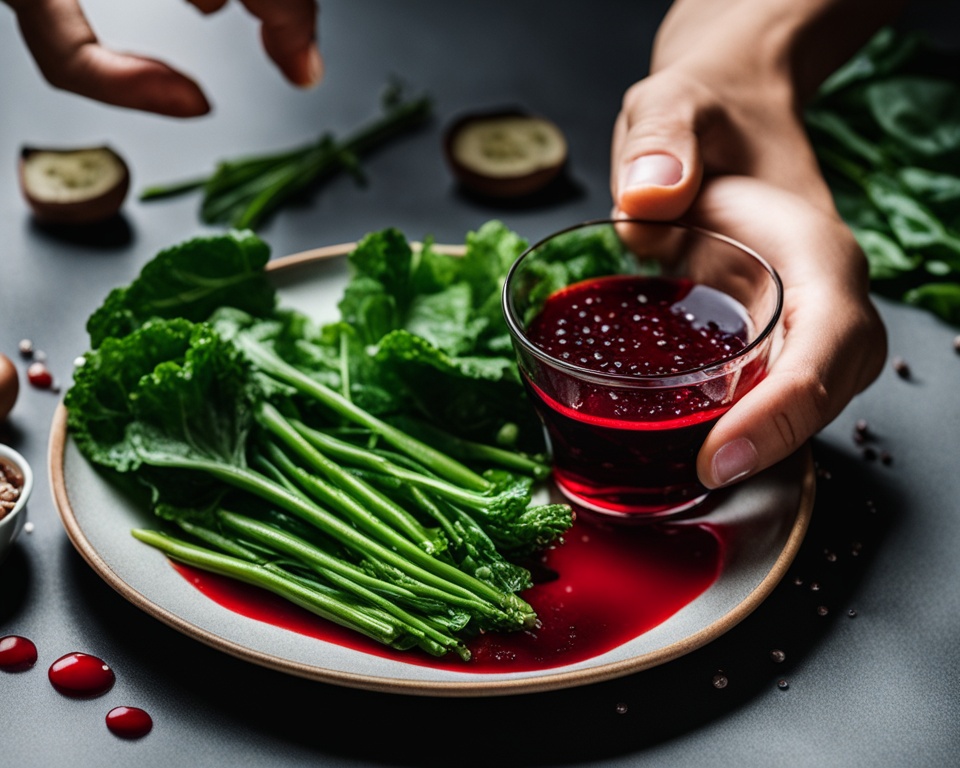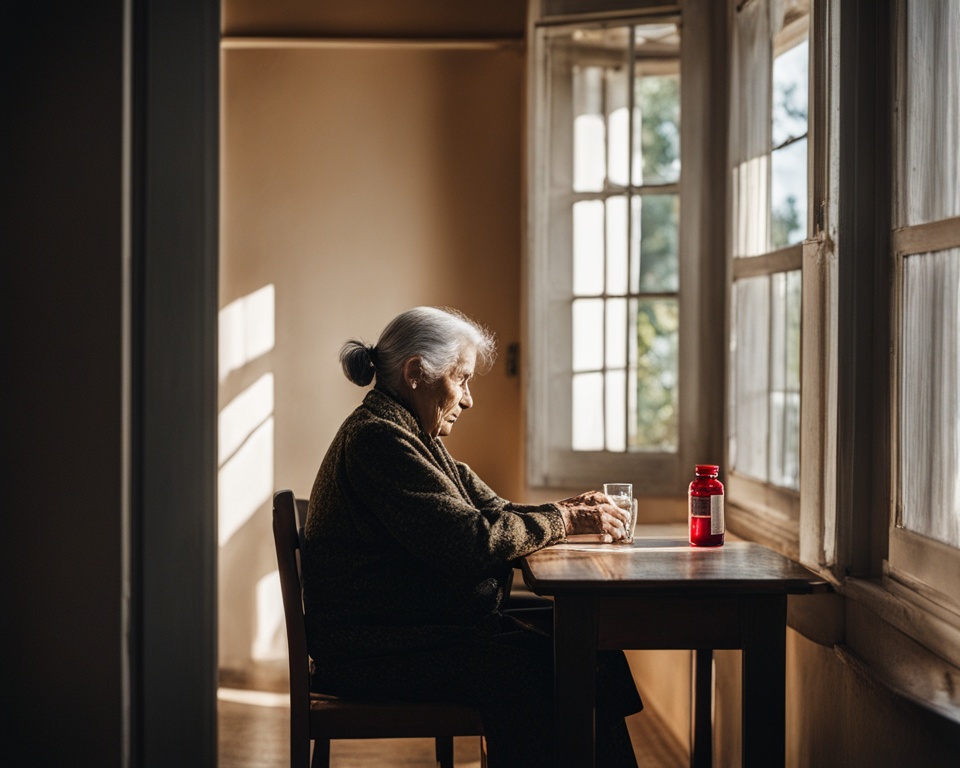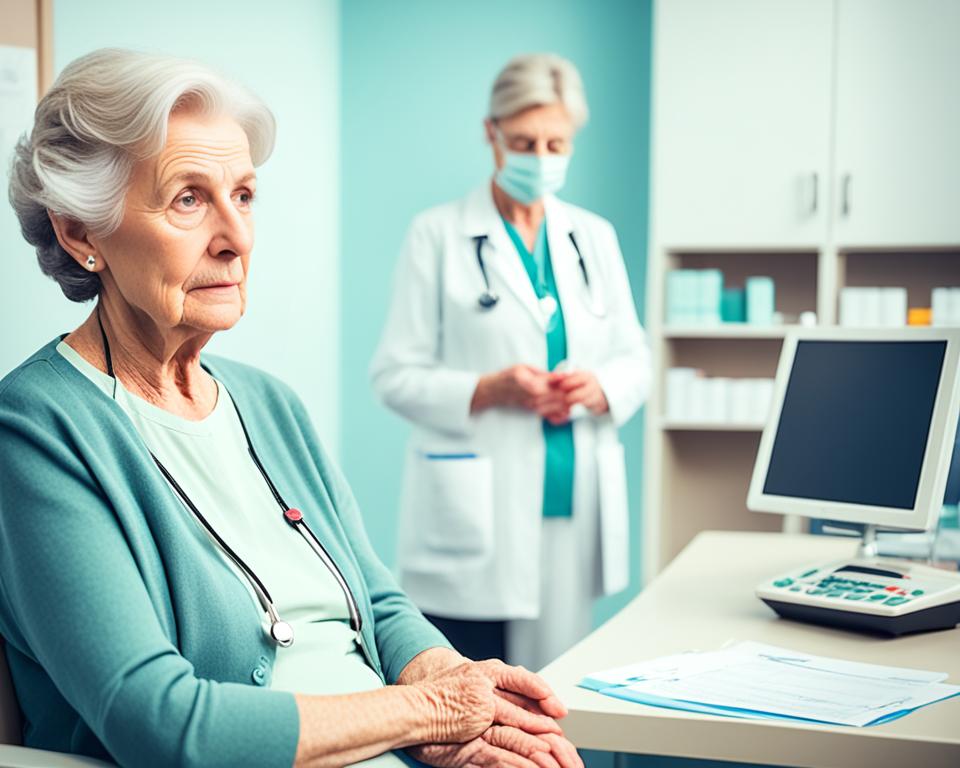As we get older, our bodies change in many ways. One common issue for elderly women is low hemoglobin, or anemia. Hemoglobin is key for carrying oxygen in our blood. It’s vital for our energy, health, and how well we live.
This guide looks at why some elderly women have low hemoglobin. It talks about symptoms and how to treat it. It also covers how common anemia is in older women and why acting fast is important.
Read interesting things at : kamilyle
Key Takeaways
- Anemia is a common concern for elderly women, affecting their overall health and quality of life.
- Identifying the underlying causes of low hemoglobin, such as iron deficiency, vitamin deficiencies, and chronic diseases, is crucial for effective treatment.
- Timely diagnosis and appropriate medical interventions, including dietary changes and supplementation, can help manage low hemoglobin levels and mitigate associated complications.
- Preventive measures, such as maintaining a balanced diet and adopting healthy lifestyle habits, can play a vital role in preserving optimal hemoglobin levels in older adults.
- Caregivers play a crucial role in monitoring symptoms, ensuring treatment compliance, and supporting the overall well-being of elderly individuals with anemia.
Understanding Hemoglobin and Anemia
Hemoglobin is key to our health, carrying oxygen from the lungs to our tissues. It’s inside red blood cells and is vital for our well-being. If hemoglobin levels go down, we might get anemia, which affects our life in different ways.
Role of Hemoglobin in the Body
Hemoglobin in red blood cells grabs onto oxygen and carbon dioxide. This helps move these gases between the lungs and our body. It’s crucial for our heart to work right, making sure oxygen gets to every part of us. Not having enough hemoglobin means less oxygen gets around, causing tiredness, weakness, and other health problems.
Types of Anemia and Their Impact
- Iron Deficiency Anemia: This is the most common anemia type, caused by not having enough iron. It brings on pale skin, shortness of breath, and makes us feel less energetic and less sharp.
- Vitamin Deficiency Anemia: Not having enough vitamins like B12 and folate can also lead to anemia. This makes it hard for our bodies to make healthy red blood cells.
- Anemia Associated with Chronic Diseases: Some long-term illnesses, like cancer, kidney disease, and rheumatoid arthritis, can cause anemia as a side effect. This makes managing the main condition harder.
Anemia, no matter the cause, can really change how we live. It makes us feel tired, less sharp, and raises the risk of other health issues. Knowing about hemoglobin and anemia helps us handle and prevent this common health problem.
Prevalence of Low Hemoglobin in Elderly Women
As people get older, they face a higher risk of anemia, which means their hemoglobin levels are too low. Prevalence of anemia in elderly women is especially worrying. They are more likely to have age-related low hemoglobin than younger women.
A study in the Journal of the American Geriatrics Society found anemia in about 12% of women over 65. This is much higher than the 3% rate in younger women. This difference comes from many factors that make older women more likely to get anemia.
- Hormonal changes after menopause can make it harder for the body to absorb iron, leading to iron deficiency anemia.
- Older women often eat less and may not get enough iron, folate, and vitamin B12. This makes them more likely to get anemia.
- Chronic health issues like kidney disease, cancer, and stomach problems are common in older people. These can also cause anemia.
Knowing how common anemia is in older women helps us find ways to prevent and treat it. By tackling the main causes and using the right treatments, doctors can lessen the effects of age-related low hemoglobin on senior women’s health and happiness.
“Anemia is a common and often overlooked condition in the elderly, particularly among women. Addressing this issue can significantly improve the overall health and quality of life for this vulnerable population.”
Causes of Low Hemoglobin in Elderly Female
As we age, our bodies face unique challenges that can lead to low hemoglobin levels, especially in elderly females. It’s important to know the main causes to help with care and prevention.
Iron Deficiency Anemia
Iron deficiency anemia is a top reason for low hemoglobin in elderly females. Iron is key for making hemoglobin, which carries oxygen in the body. Older bodies may struggle to absorb and use iron, causing a deficiency and anemia.
Vitamin Deficiencies
Vitamins like B12 and folate are also important for making red blood cells. Without them, the body can’t make healthy hemoglobin. This can lead to low hemoglobin levels in the elderly.
Chronic Diseases and Inflammation
Chronic diseases like kidney disease, cancer, and rheumatoid arthritis can cause anemia in elderly females. These diseases can affect how the body makes or uses hemoglobin, leading to low levels and symptoms.
Chronic inflammation, common in older adults, can also mess with iron levels, making anemia worse.
“Understanding the underlying causes of low hemoglobin is the first step in addressing this common issue in elderly females.”
Symptoms of Anemia in Seniors
It’s important to know the signs of anemia in older people. Anemia means having low hemoglobin levels. It can cause symptoms that might seem like part of aging. Spotting these signs early helps in treating anemia in seniors.
Fatigue and weakness are common in seniors with anemia. They might always feel tired and struggle with everyday tasks. This can really affect their life and how independent they feel.
Seniors with anemia may also have shortness of breath. This happens when the body can’t carry oxygen well because of low hemoglobin. Even simple activities can make them breathe hard.
Look for pale skin and pale mucous membranes like the lips and gums in older people with anemia. This color change comes from having fewer red blood cells and less hemoglobin.
- Cognitive impairment and confusion
- Dizziness and lightheadedness
- Rapid or irregular heartbeat
- Chest pain
- Headaches
These symptoms don’t always mean someone has anemia. They can also be signs of other health issues. But if an older person has several of these, they should see a doctor to check for anemia.
Knowing the anemia symptoms in elderly and signs of low hemoglobin in older adults helps caregivers and doctors. They can then take steps to help seniors with anemia and make their lives better.
Diagnosis and Screening
Diagnosing anemia in elderly women means checking their hemoglobin levels and overall health. The first step is a simple blood test. This test looks at the oxygen-carrying protein in red blood cells.
Blood Tests for Hemoglobin Levels
A complete blood count (CBC) is key for diagnosing anemia in elderly. This test checks the levels of different blood parts, like red blood cells, white blood cells, and platelets. The hemoglobin level is crucial. If it’s below normal, it might mean anemia.
Additional Diagnostic Tests
If blood tests show low hemoglobin, doctors might order more tests. These help find the cause of the anemia. Some tests include:
- Iron panel: Looks at iron, ferritin, and other iron markers to spot iron deficiency anemia.
- Vitamin B12 and folate tests: Checks for these important vitamins, which can cause anemia if low.
- Kidney function tests: Finds any kidney problems that might affect red blood cell production.
- Inflammatory markers: Looks at C-reactive protein and other markers for chronic inflammation as an anemia cause.
By using these tests for anemia, doctors can understand why the elderly woman’s hemoglobin is low. They can then create a specific treatment plan.
Treatment Options for Low Hemoglobin in Elderly Female
Dealing with low hemoglobin levels in elderly women needs a detailed plan. First, find and fix any underlying issues like iron or vitamin shortages, or chronic health problems. Then, doctors can suggest specific treatments to help increase healthy hemoglobin levels and better health.
Iron Supplements and Diet Changes
Iron supplements are often used to treat anemia from iron lack. They help add iron back to the body and increase hemoglobin. Eating more iron-rich foods like red meat, leafy greens, and fortified cereals also helps improve iron levels.
Vitamin Supplementation
Not having enough vitamins like B12 or folate can also cause anemia. In these cases, doctors might suggest vitamin supplements. These supplements help fix the nutrient imbalance and support making healthy red blood cells.
Addressing Underlying Conditions
For elderly women with anemia from ongoing health issues, like chronic inflammation or kidney disease, treating the main condition is key. This might mean adjusting medications, controlling what you eat, or dealing with other anemia causes.
| Treatment Option | Targeted Condition | Potential Benefits |
|---|---|---|
| Iron Supplements | Iron Deficiency Anemia | Replenishes iron stores and boosts hemoglobin production |
| Vitamin Supplements | Vitamin Deficiency Anemia | Addresses specific nutrient imbalances and supports red blood cell production |
| Managing Underlying Conditions | Anemia due to Chronic Diseases | Targets the root cause of the anemia and improves overall health |
By using these treatments together, doctors can help elderly women with low hemoglobin levels. This improves their life quality and lowers the risks of not treating anemia.

Preventing Anemia in Older Adults
As we get older, keeping our hemoglobin levels healthy is crucial. Luckily, older adults can take steps to avoid anemia and boost their health.
Dietary Recommendations
Eating a diet full of nutrients is vital for preventing anemia in seniors. Make sure to include these foods in your meals:
- Iron-rich foods like lean red meat, poultry, fish, beans, lentils, and fortified cereals
- Vitamin C-rich fruits and vegetables to help your body absorb iron better
- Vitamin B12-rich foods such as dairy products, eggs, and seafood
- Folate-rich foods like leafy greens, citrus fruits, and whole grains
Lifestyle Modifications
Along with a healthy diet, some lifestyle changes can also help prevent anemia in older adults:
- Stay active to improve blood circulation and oxygen delivery
- Manage chronic conditions like diabetes, kidney disease, or inflammatory disorders that can lead to anemia
- Stop smoking and drink less alcohol, as they can affect iron absorption
- Keep your teeth clean to avoid bleeding gums, which can cause iron loss
By focusing on a diet rich in nutrients and making lifestyle changes, older adults can effectively prevent anemia in aging. This helps them stay healthy and well.
Low Hemoglobin in Elderly Female
Keeping hemoglobin levels right in older women is tough. As we get older, the chance of getting low hemoglobin, or geriatric anemia goes up. This is because of many reasons. It’s important for doctors to know about low hemoglobin in elderly female to catch it early and treat it well.
Iron deficiency anemia is a big reason why older women might have low hemoglobin. This can happen if they don’t eat well, can’t absorb nutrients, or lose blood over time. Geriatric anemia can also come from not getting enough vitamins like B12 or folate. Or it could be because of other health issues like kidney problems, thyroid issues, or inflammation.
Signs of low hemoglobin in elderly female can be easy to miss. They might feel tired, weak, short of breath, or not think as clearly. It’s key to check regularly and do blood tests to catch this early.
Addressing Low Hemoglobin in Elderly Females
To manage low hemoglobin in elderly female, we need to do a few things. This includes:
- Making diet changes to get more iron, vitamins, and nutrients
- Taking iron, vitamin B12, or folate if needed
- Fixing any health issues that cause anemia
- Keeping an eye on and managing chronic diseases that affect hemoglobin
By tackling low hemoglobin in elderly female early, doctors can make them healthier. This can also make their life better and lower the chance of other problems.
It’s very important to keep hemoglobin levels in elderly female right. Doctors need to be careful in checking, finding, and treating geriatric anemia. This helps older women stay healthy and live better.
Complications of Untreated Anemia
Anemia, with its low hemoglobin levels, can be serious if not treated, especially for the elderly. It’s important to know the complications of untreated anemia and the risks of low hemoglobin in the elderly. This knowledge helps keep seniors healthy and happy.
Untreated anemia in seniors can lead to more hospital stays. People with anemia may feel tired, weak, and short of breath. These symptoms make everyday tasks hard and increase the chance of falling or getting hurt. This can mean more trips to the hospital.
Also, anemia can cause cognitive decline in the elderly. Low hemoglobin levels don’t deliver enough oxygen to the brain. This can lead to memory loss, confusion, and other thinking problems. Such issues can greatly affect a person’s life and independence.
Another big problem with untreated anemia is heart issues. Anemia makes the heart work too hard to move oxygenated blood around. This can cause heart failure, angina, and other heart problems.
| Complication | Impact |
|---|---|
| Increased Hospitalization Risk | Anemia can lead to symptoms that increase the likelihood of falls, accidents, and other events requiring hospital care. |
| Cognitive Decline | Low hemoglobin levels can impair oxygen delivery to the brain, potentially contributing to memory loss and other cognitive impairments. |
| Cardiovascular Problems | Anemia can strain the heart, leading to the development or worsening of conditions such as heart failure, angina, and arrhythmias. |
It’s key to catch and treat anemia early in the elderly to avoid these serious issues. Regular check-ups, blood tests, and tackling anemia’s causes can reduce the risks of low hemoglobin in the elderly.
Anemia and Quality of Life
Anemia is common in older women and can greatly affect their life quality. Symptoms like fatigue, weakness, and shortness of breath make it hard to do daily tasks. This can take away their independence.
Anemia also affects mental and social health in older people. It can lead to depression, anxiety, and thinking problems. This makes life even harder.
A study in the Journal of the American Geriatrics Society showed anemia in the elderly leads to worse physical function, more hospital stays, and less social interaction. This is compared to those without anemia.
“Anemia can profoundly impact an elderly person’s ability to maintain their independence and engage in the activities they enjoy. Managing anemia is crucial for preserving quality of life in the senior years.”
Anemia hits older women harder because they face more challenges as they age. Finding and treating the cause of anemia can lessen its effects. This can make them feel better overall.
| Aspect of Quality of Life | Impact of Anemia |
|---|---|
| Physical Functioning | Decreased stamina, weakness, and fatigue |
| Mental Health | Increased risk of depression, anxiety, and cognitive decline |
| Social Engagement | Reduced participation in social activities and community involvement |
| Independence | Difficulty performing daily tasks and maintaining self-care |
By tackling anemia and its causes, doctors can boost the life quality of older women. This helps them stay independent and active later in life.
Caregiving for Elderly with Anemia
Caring for an elderly loved one with anemia means more than just giving them medicine. It’s about watching for symptoms, making sure they take their treatment, and working with doctors to keep them healthy.
Monitoring Symptoms
It’s important to watch for anemia symptoms in older adults. Look for signs like:
- Fatigue and weakness
- Pale skin and nail beds
- Shortness of breath
- Dizziness or lightheadedness
- Rapid or irregular heartbeat
By keeping an eye on these signs and noting any changes, you help the healthcare team make the best treatment plans.
Ensuring Compliance with Treatment
It’s key for older adults with anemia to stick to their treatment plans. You can help by making sure they take their medicine, eat right, and go to doctor’s appointments. Here are some ways to help:
- Set a routine and use reminders for taking medicine
- Give them foods rich in iron and other important nutrients
- Go to doctor’s visits with them and talk with their doctor
- Encourage them to talk about any problems or worries with taking their treatment
Working with the healthcare team and being active in caregiving can greatly improve your elderly loved one’s life with anemia.
Age-Related Factors Contributing to Anemia
As we get older, our bodies change in ways that can lead to anemia. Anemia is when our hemoglobin levels are too low. It’s important to know why anemia is more common in older people.
One big reason for anemia in the elderly is poor nutrient absorption. Our bodies don’t absorb vitamins and minerals like iron, vitamin B12, and folate as well as they used to. These nutrients are key for making hemoglobin.
Also, the bone marrow, where red blood cells are made, doesn’t work as well with age. This means fewer red blood cells are made, leading to lower hemoglobin levels and anemia.
Chronic conditions like age-related factors anemia also play a big role in how aging affects hemoglobin levels. Diseases such as kidney disease, chronic inflammation, and cancer can make it hard for the body to make and use hemoglobin.
“Anemia in the elderly is often multifactorial, with a combination of age-related changes and underlying medical conditions contributing to the problem.”
Knowing about these factors helps us find ways to prevent and treat anemia in older people. By tackling the main causes and using the right treatments, doctors can improve the health and life quality of older adults.

Anemia and Comorbidities in the Elderly
Anemia is a common health issue among the elderly. It often happens with other chronic conditions, making it harder to manage. It’s important to understand how anemia and other health issues work together for older adults.
Heart disease is a big issue for seniors with anemia. Anemia can make heart failure worse, raising the risk of being hospitalized or dying. People with kidney disease often have anemia too. This can make kidney function worse and speed up the disease.
Cancer can cause or be made worse by anemia. Anemia might come from the cancer, its treatments, or poor nutrition. Helping seniors with cancer manage their anemia is key to a good quality of life and better treatment results.
For seniors, anemia and dementia often go hand in hand. Research shows anemia might increase the risk of losing cognitive function. It can also make Alzheimer’s disease and other dementia types worse.
| Comorbidity | Impact on Anemia | Anemia’s Impact on Comorbidity |
|---|---|---|
| Cardiovascular Disease | Anemia can worsen heart failure symptoms and increase the risk of hospitalization and mortality. | Anemia can exacerbate the symptoms of heart failure and contribute to the progression of the disease. |
| Chronic Kidney Disease | Anemia is a common complication of chronic kidney disease, often arising due to reduced erythropoietin production. | Anemia can further impair renal function and contribute to the progression of chronic kidney disease. |
| Cancer | Anemia may arise due to the cancer itself, the side effects of cancer treatments, or nutritional deficiencies. | Effectively managing anemia in elderly cancer patients is essential for maintaining their quality of life and optimizing treatment outcomes. |
| Cognitive Impairment | Studies suggest that anemia may be linked to an increased risk of cognitive decline. | Anemia may exacerbate the symptoms of Alzheimer’s disease and other forms of dementia. |
Handling anemia in older adults with other health issues needs a team approach. Doctors from different fields must work together. Keeping a close eye on the patient, making treatment plans just for them, and working together is key to managing anemia well.
“Treating anemia in the elderly requires a comprehensive understanding of their unique health challenges and the interplay between various chronic conditions.”
Emerging Treatments and Research
Researchers are looking into new ways to help elderly women with anemia. They are studying new treatments and doing important studies. These could make diagnosing, preventing, and treating anemia in older people more effective.
Newer Therapeutic Approaches
Intravenous iron supplementation is a new hope for elderly people with anemia. It puts iron right into the bloodstream, which works better than iron pills for some people. This is because some older folks have trouble absorbing iron from food or pills.
Experts are also looking at erythropoiesis-stimulating agents (ESAs). These are drugs that help make more red blood cells. They’ve helped people with kidney disease, and might help older adults too.
Ongoing Research
- Studies are checking if vitamin B12 and folate supplements can help with anemia in older people. These vitamins are important for making red blood cells.
- Researchers are looking into how eating more iron-rich foods can help older adults with anemia.
- They’re also studying combination therapies. This means using different treatments together to tackle the many causes of anemia in older people.
As we learn more about new treatments for anemia in elderly and research on anemia in older adults, doctors and caregivers can give the best care to their patients. This includes women who have low hemoglobin levels.
Conclusion
Low hemoglobin levels in elderly women are a big health concern. It’s important to understand the causes, symptoms, and how to treat it. Healthcare workers can greatly help by focusing on this issue.
It’s key to find and fix the causes like iron or vitamin shortages, and chronic illnesses. Regular checks, quick diagnoses, and tailored treatments help a lot. These can include changing diets, taking supplements, and managing other health issues.
Helping elderly women and their caregivers understand and work on this issue is also crucial. By working together, doctors, patients, and families can help seniors keep their hemoglobin levels right. This way, they can live full, independent lives.


